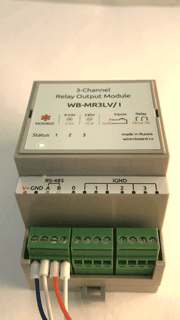Загрузка прошивок на устройства Wiren Board
Это утверждённая версия страницы. Она же — наиболее свежая версия.
Внимание: Отображаемое название «Загрузка прошивок на устройства Wiren Board» переопределяет ранее заданное отображаемое название «WB-MCU-Flasher».
Firmware bootloader
The new versions of our devices have a firmware bootloader. It allows you to update the firmware of our devices/Wiren Board modules via RS-485/Modbus RTU. The bootloader mode, in which it is possible to update the firmware, has been added to the devices.
In the bootloader mode, the main functionality of the device is disabled. Communication parameters in the bootloader mode are fixed and do not depend on the values in the device memory: 9600 8N2.
Entering bootloader mode
The device enters bootloader mode if:
- the device has the correct firmware — the first 2 seconds after power on, the device operates in bootloader mode;
- the device does not have the correct firmware (for example, there was a failure when updating the firmware) — in this case, the bootloader mode is constantly active;
- when the main program in the holding-register 129 (0x81) was recorded 1 — in this case, the device is rebooted and remains in bootloader mode for 120 seconds.
Bootloader mode indication: the device Status indicator rarely flashes. When you download a new firmware, indicator stops changing state.
Firmware
Writing firmware in the memory device is performed by a loader that gets its Modbus RTU. Firmware is stored in files with extension .wbfw. Currently available firmwares are available on request.
Device signatures
When flashing at the factory, the signature — the name of the hardware type of the device — is recorded into the memory of the device. When overwriting the firmware, the current signature is compared with the firmware signature. Writing new firmware is possible only if the signatures match.
Modbus
The device loader receives firmware via Modbus RTU. In the bootloader mode, the communication parameters are fixed and do not depend on the previous values in the device memory: 9600 8N2. According to the Modbus protocol, the device can be set to bootloader mode, if 1 is written to the holding register 129 (0x81) during the operation of the main program. In this scenario, the device restarts and remains in bootloader mode for 120 seconds.
The Modbus address of the bootloader firmware device should be selected as follows:
- The main address for the firmware is the address specified in the device memory: that is, it is the standard address to which the device responds from the main program.
- To flash a device using a broadcast address of 0. This is a less preferred method.
Utility for WB-mcu-fw-flasher firmware
To transfer firmware to the devices, use the wb-mcu-fw-flasher utility launched from the Wiren Board controller (or a computer with Linux or Windows).
To install the utility on the Wiren Board controller, run the following commands:
apt-get update apt-get install wb-mcu-fw-flasher
Software for MS Windows can be downloaded here: Wb-mcu-fw-flasher_1.0.2.zip.
To install on a Debian computer, download the package from here: Wb-mcu-fw-flasher_1.0.2_amd64-all.deb and execute commands in the directory where the package was downloaded.
apt-get update apt-get install libmodbus5 dpkg -i Wb-mcu-fw-flasher_1.0.2_amd64-all.deb
wb-mcu-fw-flasher utility starting options:
| Option | Description | Value by default |
|---|---|---|
| -d | serial port device | |
| -f | firmware file | |
| -a | Modbus address | 1 |
| -j | Send a command to the device to enter bootloader mode | |
| -r | Address of the holding register to enter bootloader mode | 129 |
| -D | Enable debug mode |
Пример:
wb-mcu-fw-flasher -j -d /dev/ttyRS485-1 -a 25 -f WB-MR-MR6C_MCU3_3_1.9.4.wbfw
The example for Windows:
wb-mcu-fw-flasher.exe -j -d COM10 -a 25 -f WB-MR-MR6C_MCU3_3_1.9.4.wbfw
COM10 is the name of the virtual serial port that is assigned to the USB RS-485 adapter.
Device flashing
When flashing from the controller, stop wb-mqtt-serial:
service wb-mqtt-serial stop
Connect the device to RS-485.
If you do not know the exact hardware type of the device, you can read its signature with the command:
export mbusaddr=1; echo -e `modbus_client --debug -mrtu -pnone -s2 /dev/ttyRS485-1 -a$mbusaddr -t0x03 -r290 -c 12 | grep Data | sed -e 's/0x00/\x/g' -e 's/Data://' -e 's/s//g'`| xxd -r -p && echo ''
Specify the address of the flash device in a mbusaddr variable.
In the output of the command, you will get the device signature, for example, wbmr6c.
Select the appropriate firmware, for example, WB-MR-MR6C_MCU3_3_1.9.4.wbfw.
Flash the device with the command:
wb-mcu-fw-flasher -j -d /dev/ttyRS485-1 -a 25 -f WB-MR-MR6C_MCU3_3_1.9.4.wbfw
The successful firmware process is as follows:
wb-mcu-fw-flasher -j -d /dev/ttyRS485-1 -a 1 -f WB-MR-MR6C_MCU3_3_1.9.4.wbfw /dev/ttyRS485-1 opened successfully. Send jump to bootloader command and wait 2 seconds... Error: Connection timed out. May be device already in bootloader, try to send firmware... WB-MR-MR6C_MCU3_3_1.9.4.wbfw opened successfully, size 12136 bytes Sending info block... OK Sending data block 89 of 89... OK. All done!
After successful flashing, the device will exit the bootloader mode itself and restart in the main program.
The example of a signature mismatch error:
Sending info block... Error while sending info block: Slave device or server failure Data format is invalid or firmware signature doesn't match the device
Firmware devices on the Modbus broadcast address 0
Bootloader allows you to download firmware to devices via Modbus address 0. To do this, the device must be the only device on the bus and must be in bootloader mode.
Flashing several devices on the bus
It is possible to flash several devices connected to the bus. The devices must be set to bootloader mode and flashed separately with a non-broadcast Modbus address. Flashing devices with the same address is possible if only one of them is in the bootloader mode. The devices shall be flashed at a time.
Attention! The flashing of the devices in bootloader mode and of the same modbus address, or the flashing of multiple devices being in the bootloader mode at address 0 will not be performed; the existing firmware of the device will be ruined.
